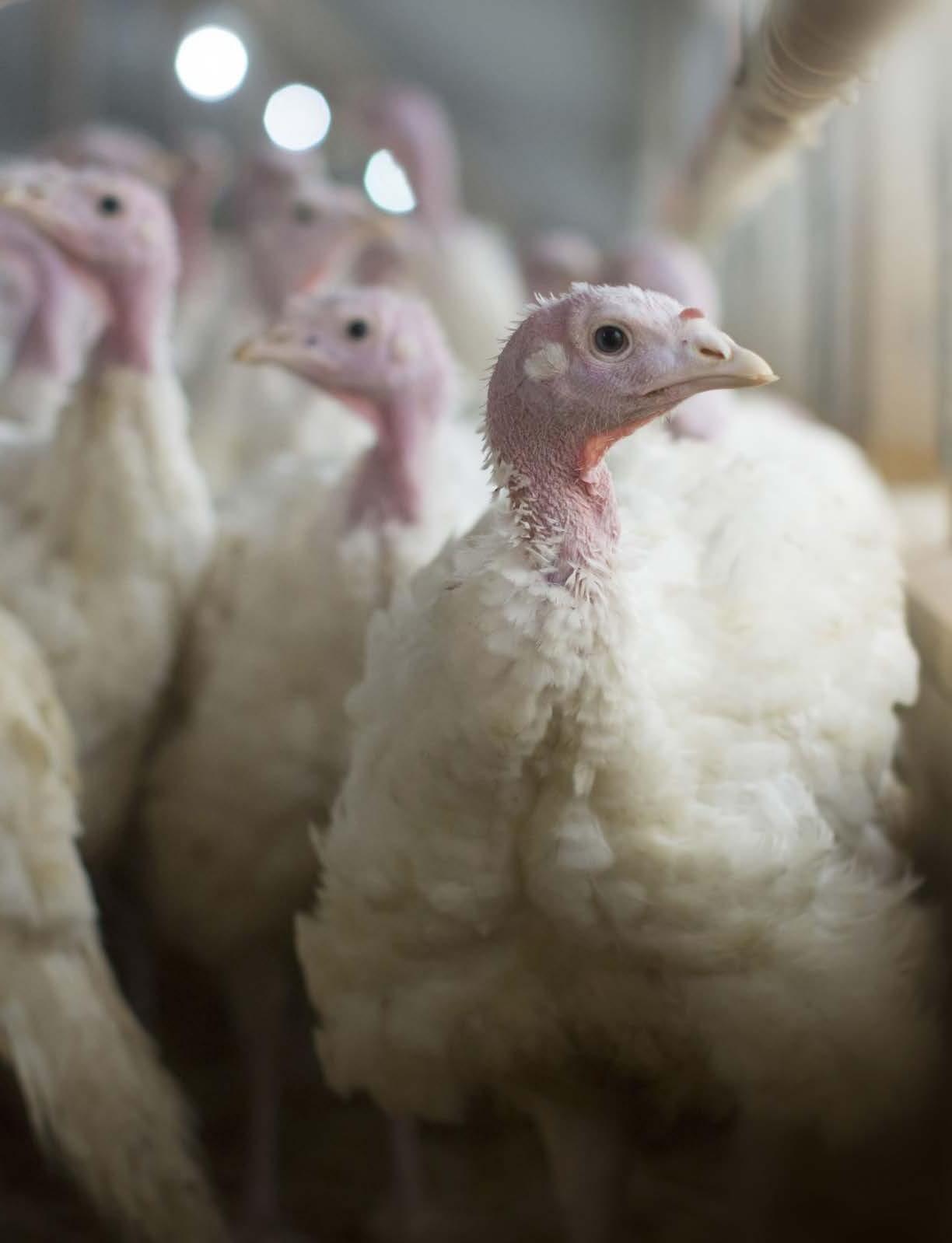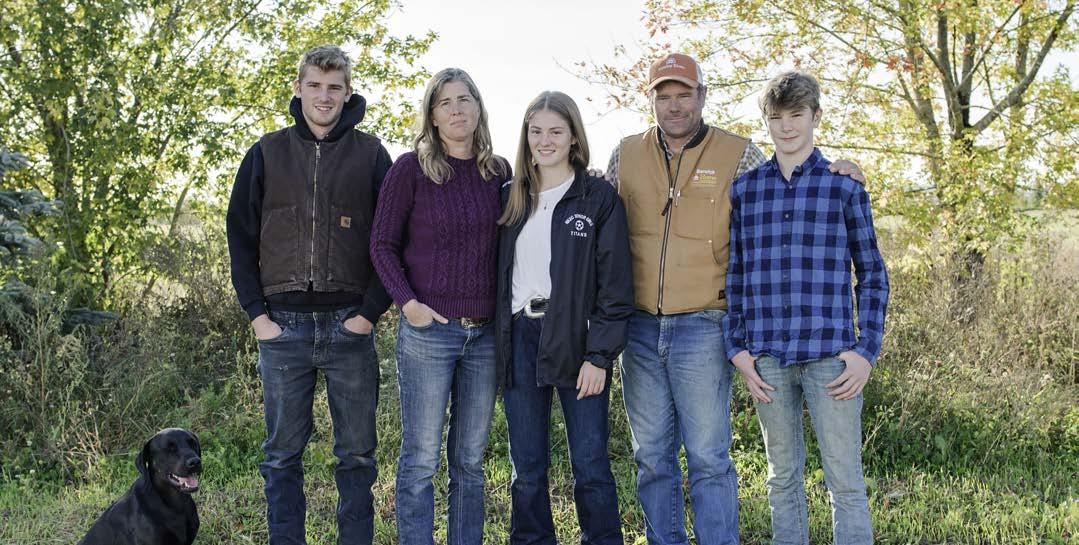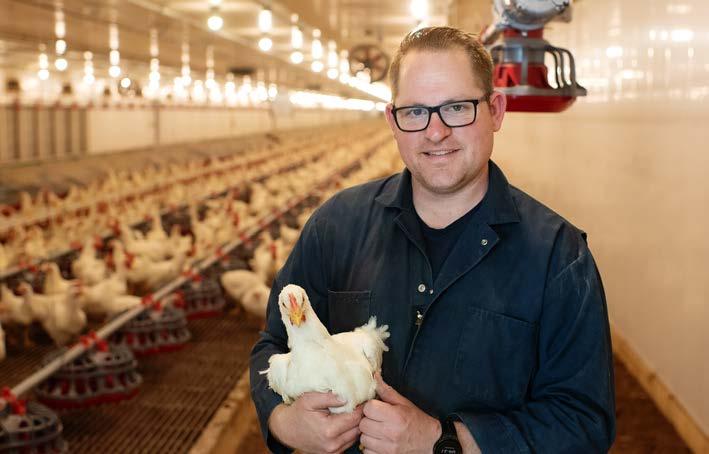

2025 STATE OF THE INDUSTRY REPORT
Full results of our national producer survey with expert commentary from across Canada’s poultry sector.

SPONSORED BY PRESENTED BY

From the Editor
by Brett Ruffell
Why we took the pulse
When you work in an industry as dynamic and demanding as poultr y, questions are constant. What’s keeping producers up at night? Which pressures feel different than they did even a few years ago? These are questions we ask every day in our reporting and in interviews, but sometimes it’s worth taking a wider look – to pause and ask them all at once.
That curiosity inspired Canadian Poultry’s first-ever State of the Industry Survey. We wanted to capture a snapshot of how producers across Canada are managing in 2025 – what’s working, what’s challenging and what’s changing fastest. Over the years, we’ve written about everything from avian influenza and automation to sustainability and succession planning. But this time, we wanted to see how those threads connect across different poultry sectors.
Our survey ran from early May to late June, and received 169 responses nationwide. It featured 45 questions, mostly multiple choice, covering production challenges, technology adoption, labour, animal health, and the future outlook of Canadian poult-
ry. Respondents were entered into a draw for a $50 gift card, but the real reward was the insight they offered.
This project was made possible through the support of Georgia Poultry, our survey sponsor. Their partnership helped us collect a richer and more representative picture of Canadian poultry production – one that will inform both our editorial coverage and the broader industry discussion in the months ahead.
To help interpret the data, we also spoke with three producer leaders who live these realities daily: Darren Ference, a turkey producer and chair of Turkey Farmers of Canada; Krista Oulton, a chicken and egg producer and chair – pullet director with Egg Farmers of Nova Scotia; and Shane Driessen, a hatching egg producer and director with the B.C. Hatching Egg Commission. Their perspectives add real-world context to the numbers.
If there’s a single takeaway, it’s this: Canadian poultry producers are balancing tradition with transformation. They’re practical, resilient and focused on the long game. The following pages share what they told us – and what the future might look like because of it.
canadianpoultrymag.com
Reader Service
Print and digital subscription inquiries or changes, please contact Angelita Potal, Customer Service Rep.
Tel: (416) 510-5113
Email: apotal@annexbusinessmedia.com
Mail: 111 Gordon Baker Rd., Suite 400, Toronto, ON M2H 3R1
Editor Brett Ruffell bruffell@annexbusinessmedia.com 226-971-2133
Brand Sales Manager
Ross Anderson
randerson@annexbusinessmedia.com Cell: 289-925-7565
Account Coordinator
Julie Montgomery jmontgomery@annexbusinessmedia.com 416-510-5163
Media Designer Curtis Martin
Group Publisher Michelle Bertholet mbertholet@annexbusinessmedia.com
Audience Development Manager
Anita Madden amadden@annexbusinessmedia.com 416-510-5183
CEO Scott Jamieson sjamieson@annexbusinessmedia.com
PUBLICATION MAIL AGREEMENT #40065710
Printed in Canada ISSN 1703-2911
Subscription Rates
Canada - Single-copy $10.00
Canada – 1 Year $33.15
Canada – 2 years $56.61
Canada – 3 years $78.54 (plus applicable taxes)
USA – 1 Year $93.33 CDN
Foreign – 1 Year $105.57 CDN
GST - #867172652RT0001
Occasionally, Canadian Poultry Magazine will mail information on behalf of industry-related groups whose products and services we believe may be of interest to you. If you prefer not to receive this information, please contact our circulation department in any of the four ways listed above.
Annex Privacy Officer privacy@annexbusinessmedia.com Tel: 800-668-2374
No part of the editorial content of this publication may be reprinted without the publisher’s written permission. ©2025Annex Business Media. All rights reserved. Opinions expressed in this magazine are not necessarily those of the editor or the publisher. No liability is assumed for errors or omissions. All advertising is subject to the publisher’s approval. Such approval does not imply any endorsement of the products or services advertised. Publisher reserves the right to refuse advertising that does not meet the standards of the publication.

Meet the next generation of Canadian agri-food leaders
These exceptional students are the winners of the 2025 CABEF Scholarships. We are proud to support each of them with $2,500 for their ag-related post-secondary education.
Help us empower more students to pursue diverse careers in agri-food. Strengthen the future of Canadian agriculture and food by investing in the cream of the crop.
Become a Champion of CABEF and directly support a scholarship for a Canadian student.
Congratulations to this year’s CABEF scholarship recipients.

Leah Newcombe

Cambridge, NS Allison Morse Hatley, QC

Abbigail Mettler
Wallenstein, ON

Messina Schrof Starbuck, MB

Morgan Debenham Kennedy, SK

Colby Scott Hanna, AB

Contact CABEF today to learn how you can become a “Champion of CABEF” at info@cabef.org
Zeyus Spenta North Vancouver, BC
The results are in
What we learned about how poultry producers are managing risk, embracing technology and preparing for the future.
by Brett Ruffell
Poultry production in Canada has always been defined by its diversity –in geography, climate, markets, and farm structure. Yet some challenges transcend region and species. To better understand those realities, Canadian Poultry asked producers to share what’s driving their decisions in 2025.
The survey ran from May 8 to June 30 and drew 169 responses. Most respondents (over 60 per cent) were from Ontario and Alberta, with strong representation from the Atlantic provinces and British Columbia. The survey included 45 questions, primarily multiple choice, covering everything from cost pressures and automation to biosecurity and succession.
Results were later discussed with three producers who bring both provincial and national perspectives.
Respondents
Survey Panel
Commentary and insights provided by:



Darren Ference Co-owner, Raeyson’s Poultry; Chair, Turkey Farmers of Canada
Krista Oulton Co-owner, Oultons Poultry Farm; Chair, Pullet Director, Egg Farmers of Nova Scotia
Shane Driessen President, G&G Poultry Ltd.; Director, B.C. Hatching Egg Commission

Supply management: confidence and vigilance
88% express at least some concern about the impact of international trade agreements on Canada’s supply management system.
60% say the current supply management system effectively supports Canadian poultry producers.
In our survey, 60 per cent of respondents said the current supply management system effectively supports Canadian poultry producers. Yet many also flagged ongoing concerns about trade negotiations and gradual quota erosion.
Darren Ference, an Alberta-based turkey producer who chairs Turkey Farmers of Canada, calls supply management “the backbone of balance” – ensuring fair returns for producers and consistent prices for consumers. He points to recent legislation, Bill C-202, which prevents further concessions in future trade deals, as a key factor strengthening producer confidence. “It’s an important safeguard,” he says, “but we always need to be proactive, making sure policymakers understand what supply management delivers.”
Shane Driessen, a hatching egg producer and director on the B.C. Hatching Egg Commission, echoes that sentiment. He says the passage of Bill C-202 earlier this year provides real
reassurance for farmers. “I think it still adds comfort,” he says, “but we can’t take it for granted.”
For Nova Scotia’s Krista Oulton, an egg and chicken farmer, that understanding has local significance. “It’s the backbone of the rural economy,” she says, pointing to how stable farm income supports local jobs and community life.
Survey responses echoed those sentiments. While most said supply management effectively supports producers, 27 per cent disagreed, and 12 per cent were unsure. Many suggested small adjustments to improve efficiency and transparency. The overall tone was one of trust – not complacency.
When asked how future trade deals might affect their sector, respondents expressed a clear mix of apprehension and guarded hope. Many participants voiced concern that international agreements could erode the stability of Canada’s supply management system, undermining domestic production and long-term market balance.
Several noted that increased import access could directly affect quota fulfillment and farm profitability. One respondent warned that “if the new agreement allows more access to imports into Canada for the table egg market, we could not have full placement of quota allocations as shown this year.” Another added that “we could see more foreign products making their way into our food supply,” highlighting a broader unease about the potential influx of imports

Ference, first on the left, stresses that proactive support for supply management is vital to protect Canadian farmers and ensure stability for both producers and consumers.
$
What types of purchases are you planning to make in the next 12 to 24 months?
Respondents’ top five concerns for the next five years
DISEASE OUTBREAKS
RISING INPUT COSTS
LABOUR SHORTAGES
and the resulting pressure on Canadian producers.
Others took a more pointed view of supply management’s future. “We will lose more and more until supply management is off the trade table,” one respondent stated – meaning that farmers will continue losing ground in trade negotiations until Canada fully protects its supply-managed sectors by taking them off the table altogether. On the oppositive end, another respondent bluntly said, “End supply management –total transformation.”
Beyond direct references to supply management, several respondents emphasized that trade changes could ripple through the entire agri-food supply chain. Repeatedly, producers commented that “changes in trade may have significant impacts on the supply chain, particularly in the areas of food, feed, and transportation.” Some also cautioned that global political uncertainty – “anything with Trump will be negative” – could exacerbate volatility and undermine confidence in future trade agreements.
A few comments underscored the human impact of policy shifts, warning that dismantling supply management could “negatively affect family farmers and make it even harder for small farms to survive.” Overall, the tone of responses reflected strong support for maintaining protections that safeguard Canadian producers from global market fluctuations, coupled with a recognition that political and economic forces beyond farmers’ control continue to shape the future of the sector.
Managing
disease and maintaining
biosecurity
93% of respondents express at least some concern about avian influenza affecting their operation.
54% offer employees biosecurity training.
Avian influenza remains top of mind for Canadian poultry producers. Two-thirds of survey respondents said they had enhanced biosecurity measures since the 2022–2023 outbreaks, and nearly 40 per cent reported permanent infrastructure changes to mitigate future risks.
Ference says the industry has “consistently seen fewer infections each year” thanks to improved protocols and heightened awareness. His own farm in Alberta now maintains strict traffic controls and isolated equipment zones. Oulton adds that smaller, family-run farms have an advantage in managing biosecurity because fewer people come and go.
In B.C.’s Fraser Valley, where farm density is higher, Driessen and his neighbours have taken biosecurity to a new level – addressing air itself as a potential transmission route. “We’re installing filtration, UV light, and positivepressure ventilation systems,” he says. “You can’t change the geography, but you can change the air.”
The survey suggests strong alignment with that thinking. Most producers say they now view biosecurity as a “cultural” practice
rather than a checklist. Vaccine readiness, however, remains mixed – 43 per cent said they would adopt an AI vaccine if approved, while others worry about trade implications. The theme, across all responses, is vigilance: living with risk, not waiting for it.
Top 5 biosecurity practices on Canadian poultry farms
According to survey respondents, the most common biosecurity measures in place are:
• Boot dips or disinfectant mats at barn entrances (47%)
• Dedicated footwear and clothing for different barns or zones (43%)
• Signage at entry points (43%)
• Clean-out and disinfection protocols between flocks (39%)
• Handwashing or hand sanitizer stations (35%)
Rising
costs and shrinking margins
32% cite rising input costs as one of the industry’s biggest concerns over the next five years.
When asked to name their greatest operational challenges, 32 per cent of producers chose rising input costs. Feed, fuel, and labour top the list.
Ference calls it “the constant pressure point,” but cautions that cutting corners rarely saves money. “You get the best return when you stick to best management practices,” he says. “If you don’t invest in bird comfort, you lose it back in feed conversion.”
For Oulton, efficiency begins with control. Her Nova Scotia operation produces its own feed, allowing her to manage ingredient quality and stabilize costs. “Feed costs are one of the biggest challenges,” she explains. “By making our own, we know exactly what’s in it, and it helps protect us from price swings.” She also focuses on small, data-driven improvements in her barns, tracking performance to identify savings without compromising welfare or production.
In B.C., Driessen faces both commodity volatility and high labour costs. His
strategy: housing. “We provide housing for our employees,” he says. “It’s not cheap, but it keeps people long-term.”
Across the country, producers echoed a similar philosophy: efficiency, not austerity. Three-quarters of respondents said they are investing in new technology or barn upgrades to reduce operating costs.
Automation and the smart barn 54% purchased or upgraded automation/technology in the past 12 months.
Automation is no longer a luxury; it’s the norm. Eighty-one per cent of respondents said they use automated systems for ventilation, feed, or water management. Nearly half now monitor barns remotely through mobile apps or cloud-based dashboards.
Ference says that in turkey production, “there are only a few manually controlled barns left.” Environmental controls, weight monitoring, and camera systems are now standard.
Oulton, whose farm is smaller, says automation “has become the standard for ventilation and feed systems,” but egg collection remains manual for many smaller operators.
Driessen represents the leading edge of integration. His B.C. breeder facilities use PLC systems for datadriven control and an automated egg-packing system that “increased efficiency fourfold.” The goal, he says, is not replacing people but giving them “smarter tools to manage.”
Nearly half of respondents (45 per cent) said automation has significantly reduced labour challenges, with another 33.5 per cent saying it’s helped somewhat. Just 17 per cent per cent said it hasn’t made a difference, and four per cent said it doesn’t apply.
Looking ahead, 60 per cent view AI and automation in poultry farming positively, compared to only five per cent negatively. For most producers, smart barns aren’t about replacing people –they’re about working smarter, faster and more sustainably.
Are you currently using automation or artificial intelligence in your operation?
83% YES 17% No
How do you view the role of AI and automation in the future of poultryfarming? 60% 35%

Sustainability in practice
60% said sustainability is “important” or “very important” to their operation.
Sustainability isn’t new to poultry, but it’s evolving. A majority of respondents said sustainability is important to their operation, with the most common practices including waste management (66 per cent), energy reduction (59 per cent), and sustainable feed sourcing (53 per cent).
Ference calls it “a fine balance between footprint and profitability.” He believes the best sustainability investments are the ones that also improve efficiency – from manure management to feed utilization.
Oulton’s farm reflects that mindset: “We use GPS-guided tractors and no-till seeders. It saves diesel and time,” she says. She’s also been using the NESTT tool, an online platform developed for Canada’s egg farmers to help measure and reduce environmental footprint. “It’s a really valuable benchmarking tool,” she explains. “It helps you see where you’re strong and where you can do better – everything from energy use to waste management.” She’s explored solar power, but local infrastructure has delayed adoption.
Driessen, meanwhile, has already invested. His 130-kilowatt solar array now offsets more than half of his farm’s
power use, with plans to expand. Still, he cautions that “not every project makes sense on paper without government support.”
For many producers, sustainability is less about slogans and more about economics. When asked to define it, most respondents described it as “reducing inputs while maintaining productivity” – a practical definition that aligns with poultry’s reputation for efficiency.
What sustainability practices have you adopted?
• 59%: Reducing energy consumption
• 66%: Waste management and recycling
• 53%: Sustainable feed sourcing
• 24%: Water conservation
• 3%: Other
Labour and leadership
Labour shortages remain a concern, though less acute than in other agricultural sectors. About one-third of respondents said they had difficulty hiring or retaining skilled workers in the past year, and 22 per cent rely on foreign labour.
Ference says the solution is simple but not easy: “You’ve got to pay them well and treat them well.” Oulton, who employs just one outside worker, emphasizes flexibility and clear communication. Driessen takes a structural approach, offering housing and long-term stability.
Oulton (second from the left), pictured here with her family, stresses the need for early succession planning and balancing fairness among family members.
What do you see as the biggest challenges for younger farmers entering or taking over the family farm?
Interestingly, while labour was cited as a top three challenge, most respondents rated morale on their farms as “good” or “very good.” The data suggest that small, family-run models – still the majority in Canadian poultry – help buffer against turnover.
Planning for succession
40% plan to transition their poultry operation to a successor within the next 10 years.
50% say they have a formal succession plan in place for their operation.
62% see themselves continuing in poultry farming for the long term.
Succession planning is one of the survey’s starkest findings. Nearly half of respondents said they have no formal plan in place, and many admitted they haven’t yet started actively thinking about it.
Ference calls this “one of Canadian agriculture’s biggest vulnerabilities.”
His own family is currently working through a plan, and he advises others not to wait. Oulton highlights the emotional and financial complexity: “What’s fair isn’t always what’s equitable,” she says, stressing the importance of professional advice. Driessen’s family recently completed a transition and plans to start early with the next generation. “You have to have the hard conversations,” he says. Survey comments underline the same message: succession is essential, not optional. Yet many small farms remain unsure where to begin, pointing to a need for more support from boards and associations.
What are the biggest challenges you face in planning for the next generation?
• 44%: Lack of interested successor
• 54%: Financial complexity
• 59%: Legal complexity
• 37%: Family disagreements
• 23%: Transferring quota
• 20%: Giving up control
• 5%: Not enough time to plan
• 2%: Other
Do you hire outside help?

Opportunities ahead
Despite ongoing challenges, producers expressed cautious optimism about the future of Canadian poultry farming. Their comments struck a balance between optimism and caution, pointing to solid market demand, changing consumer preferences, and ongoing innovation in the industry.
Several respondents highlighted growth potential tied to population increases and the rising global demand for animal protein. “With the growing population, the need for eggs is strong as a protein source,” one participant noted, while another pointed out that “the steady cash flow helps to keep the farm going.” Others cited “growth of the poultry sector” and “still lots of potential growth for chicken” as indicators of opportunity.
Driessen shares that outlook. He points to steady demand for chicken and hatching eggs, paired with renewed interest in domestic production. “Growth is happening,” he says. “The key is keeping it sustainable and cost-efficient.”
Oulton sees growing consumer interest as another bright spot. “I’m excited by younger farmers’ creativity and tech adoption,” she says. “They’re passionate – and they’re not afraid to think differently.” That adaptability, she adds, is what will keep the sector strong in years to come.
Technology and innovation were recurring themes among survey respondents, with producers citing “AI,” “improving genetics,” and “new innovations in nutrition” as drivers of efficiency and sustainability. One producer described the industry as “everchanging – exciting for the challenges and opportunities ahead,” while another referenced “precision farming tech, alternative protein markets, and climatesmart poultry” as areas of promise.
Ference says marketing and diversification are helping maintain momentum. Turkey’s national marketing efforts are “helping move consumption beyond the holidays,” he explains, “by focusing on new cuts and processed products.”
Many respondents also saw strength in consumer trends and marketing. “I am seeing a big trend in people wanting to
buy direct from farmers,” one comment read. “Sales both at the farm and farmers markets are picking up, which can mean both lower costs for buyers and higher profits for farmers.” Others emphasized opportunities in “better marketing,” “no antibiotics and organic products,” and “niche branding” such as welfarecertified or heritage breeds.
A few connected optimism to the long-term stability of supply management and generational transition. “Being able to commit to a valuable future in supply management and allowing my family to take part,” wrote one respondent, reflecting a broader sense of continuity and resilience.
Overall, respondents and industry leaders alike framed the industry’s future as one of adaptation and opportunity. Growth, innovation, and consumer connection were consistent throughlines – suggesting that while uncertainty remains, Canadian poultry producers are positioning themselves to thrive in a changing agricultural landscape.
The state of the industry
So, what does the data tell us about Canadian poultry in 2025? It tells us this is an industry that has learned to live with volatility. Producers are realistic about the pressures they face – from avian influenza and inflation to generational change – but they’re not standing still. They’re adapting.
The numbers reveal confidence without complacency, innovation without overreach, and leadership grounded in practicality. As one respondent summed it up, “You can’t control everything, but you can control how you respond.”
That mindset may be the most valuable resource of all.

Ference highlights industry growth through campaigns like Think Turkey’s “You Turkey” that promote turkey consumption year-round and beyond traditional holiday meals.
Driessen sees strong demand and rising domestic production as signs of exciting growth opportunities ahead for Canada’s broiler hatching egg sector.
